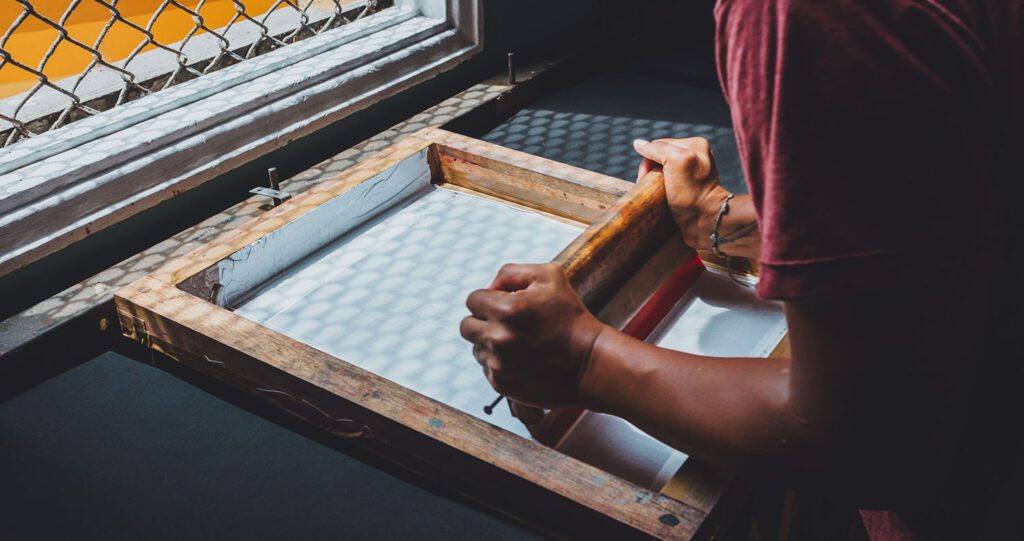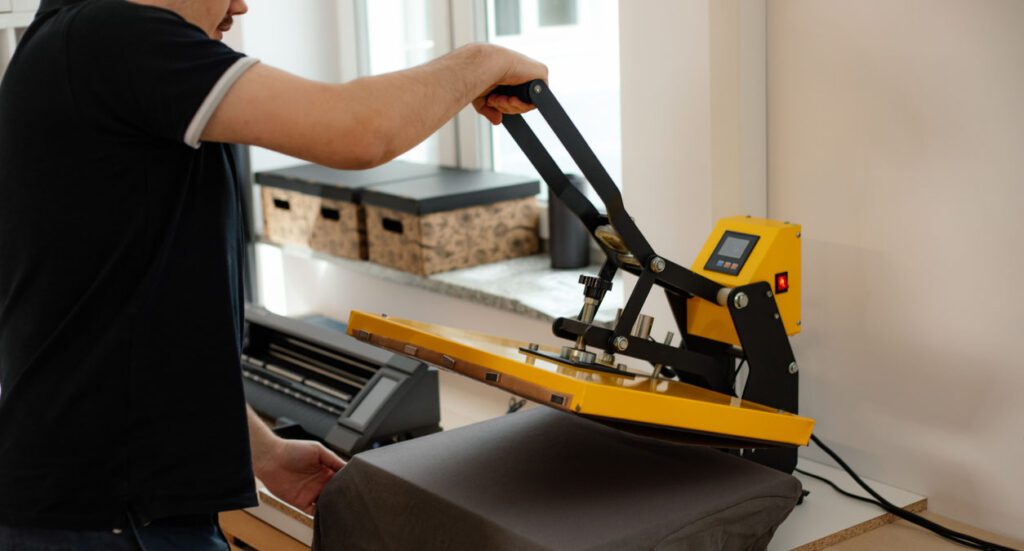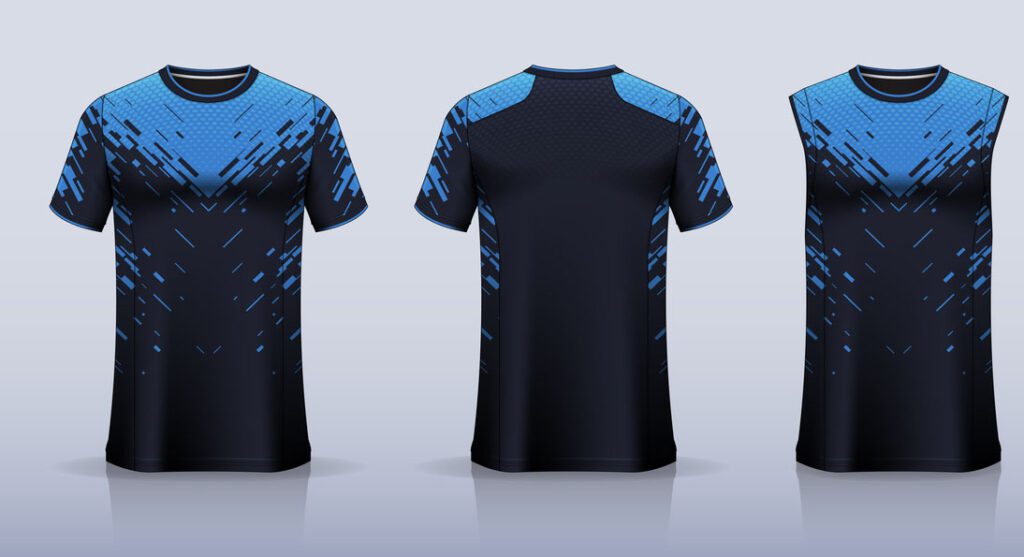If you’re itching to get into the t-shirt printing market, knowing what you need to print t-shirts from home doesn’t need to be complicated. There are plenty of low-budget options, although each method requires a specific toolset to accomplish them. What tools do you need to print t-shirts from home?
Which T-shirt Printing Methods Can You Do From Home?
Print-on-demand, screen printing, vinyl printing, heat transfers, DTG, sublimation, and DTF are all viable options for printing t-shirts at home. They have varying needs that make them less or more suitable for printing. Print-on-demand is the most budget-friendly option available.
Let’s explore different printing methods for printing t-shirts, look at what you need to do each successfully, and what you can expect for each one. You’ll see practical examples and details that will help you understand the process for each method so you can decide the best one for your needs.
Print-On-Demand
Print-on-demand is the most cost-effective method for anybody interested in printing custom t-shirts at home and selling them online. The primary reason why it’s the best option is thanks to its low barrier to entry. Here’s what you’ll need:
- You don’t require a lot of money to start – Print-on-demand is entirely free until a customer makes a purchase. If you design and upload a t-shirt, but no one purchases it, it would only cost you the time to put it up. You’ll get to adjust it or try something new to see what the customers like.
- Computer – A computer will serve as your base of operations, allowing you to design your t-shirts, advertise them, sell them, and perform other administrative tasks.
- E-commerce platform – Print-on-demand requires that you do most of the advertising on your product. Websites like Etsy, Shopify, Merch by Amazon, Teespring, and Redbubble are great for revealing your designs to a larger audience.

Shopify, for example, has a Shopify app that allows you to search for print-on-demand companies and choose from a list of hundreds.
- Print-on-demand company – Once a customer orders one of your t-shirts, your print-on-demand company will print, package, and ship your t-shirt to the customer. It doesn’t cost you anything to work with a print-on-demand company.
The only expense you incur is the cut that the print-on-demand company takes when you sell a t-shirt. This amount usually includes a sale fee and shipping fee. Companies like Printify and Printful are good options to get started.
Note that some websites like Redbubble offer options for both e-commerce and sprint-on-demand, allowing you to advertise, print & ship your t-shirts within the same domain.
- Software to design t-shirts – You don’t need expensive apps to create your t-shirt designs, but it’s a good idea to get something that can create something that looks appealing.
Software like Canva, Inkscape, and GIMP is free and contains advanced tools to help you create your ideal t-shirt. If you’re looking for something more professional, you can opt for Adobe Illustrator or Photoshop.
How Does Print-On-Demand Work?
Print-on-demand allows you to sell custom t-shirts that you design via an online platform. You can automatically send your orders to an e-commerce company that prints, packages, and ships whatever your customers buy online.
You don’t need to buy inventory upfront, print t-shirts, or spend time shipping your t-shirts – everything is an automatic online process! Print-on-demand companies don’t charge you for working with them, but you pay fees for the items you sell and shipping fees.
Here’s a run-down on the print-on-demand process:
- A customer visits your online store (Shopify, Etsy, Redbubble) and buys your t-shirt.
- When the customer pays, Shopify receives the money and holds it, and your print-on-demand company (Printify, Printful) gets an order to print, package, and ship the t-shirt the customer bought.
- When Printify receives your order, they will immediately charge you the wholesale cost for the t-shirt you sold.
- After about two days, Shopify will pay you for your t-shirt order. You’ll get reimbursement for monies spent on your wholesale t-shirt from Printify. You also receive whatever profit remains.
Screen Printing For T-Shirts
Screen printing has you using a mesh screen and ink to create a stencil on a screen. Using a squeegee, you push ink through the stencil, causing it to apply to the shirt and creating a custom t-shirt design. Here’s what you’ll need:
- A screen – The best option in terms of screen-to-shirt ratio is a size of 14” x 20”, ¾” thick.
- Photo emulsion – The emulsion is an important step that allows your design to transfer your design from the screen to your blank t-shirt.
- Emulsion remover – If you plan to apply different designs, you’ll need to remove the current emulsion on the screen and use a new layer for the new design.
- Plastisol Ink – A special ink used in screen printing to transfer a design from a screen to a t-shirt.
- One 12” squeegee – You will use the squeegee to pull the plastisol ink across the image, almost like washing a window. It’s crucial that you only use a downward motion and that you apply a reasonable amount of pressure. Pull down a maximum of two times only.
- Two clamps (optional) – Clamps are optional for improved stability. When your t-shirt is on a work surface, and you place the screen over your t-shirt, use the clamps to ensure it won’t move when you pull down with the squeegee.
- Can of spray adhesive (optional) – if you want to reduce the possibility of your screen moving while on your t-shirt, apply a light coat of adhesive to your t-shirt beforehand.
- Heat gun (optional) – Since you don’t use a heat press for this method, a heat gun can be handy for applying extra heat to help the ink bind to the t-shirt’s fabric.

What Are The Pros And Cons Of Screen Printing?
While screen printing has an inexpensive barrier to entry and produces consistently high-quality results, it has a steep learning curve. You can expect to learn about emulsion screen densities, plastisol inks, and cleaning chemicals.
For the reasons mentioned, it could be better if you plan to print only one or a few t-shirts. The value of screen printing rises when you plan to print large quantities.
Vinyl Printing On T-Shirts
Vinyl printing is one of the best methods to print your own t-shirts at home. It can deliver impressive high-quality vinyl graphics that transform blank t-shirts into beautiful apparel pieces. Note that vinyl t-shirt printing takes reasonably long and is unsuitable for bulk orders. Here’s what you’ll need:
- Computer – A computer allows you to design vinyl art to print onto your custom t-shirts. You need to connect your vinyl cutter to your computer to tell it what to cut.
- Design software – Unless you plan to purchase pre-made graphics, you’ll need to create your own. You can opt for paid apps like Adobe Photoshop with advanced features for sophisticated graphics or free-to-use apps like Canva or GIMP that also work well.
- E-commerce website – As we saw earlier, e-commerce websites are invaluable for getting your t-shirts out in front of more eyes. Domains like Redbubble also take it one step further and print, package, and ship your t-shirts.
- Blank t-shirts – Get enough blank shirts for the amount of vinyl printing you want to do.
- Polyurethane (PU) sheets or rolls – PU sheets or rolls are unique materials with heat adhesive for vinyl printing. ThermoFlex Plus is a great choice. Your vinyl cutter will create your design on a PU shape or roll. Finally, using a heat press, you’ll infuse it onto a blank t-shirt.
- Vinyl cutter – A vinyl cutter takes computer files (your graphic must be in vector file format) with patterns and letters and cuts them on a PU sheet or vinyl roll. By connecting a USB cable to a vinyl cutter, the machine will know what shape to cut.
- Heat Press – Once your vinyl cutter completes your vinyl cut, it’s time to use your heat press to infuse it onto a blank t-shirt. The Zeny Heat Press is perfect for beginners because it’s quick to set up, takes no experience, and works well for vinyl t-shirt printing.

How Does Vinyl T-Shirt Printing Work?
Vinyl printing starts by designing a vinyl using software on your computer. By connecting your PC to a vinyl cutter via a USB cable, the cutting machine will cut your graphic into a transfer paper. Take your blank t-shirt and put it on the flat surface of a heat press, and let the heat infuse the blank t-shirt.
While some people use household irons, remember that they cannot produce the same vinyl quality as heat presses because their heating element has a different consistency. A heat press is also much simpler to use – close it for 10 – 30 seconds, and you have a vinyl shirt!
Vinyl printing can print unique effects like metallics, foams, and foils. It also has options for polyester and cotton garments and takes only a couple of minutes to complete the process, from creating a vinyl to getting it onto a blank t-shirt.
Heat Transfer T-Shirt Printing
Heat Transfer T-Shirt Printing involves applying a pre-made design on transfer paper onto a blank t-shirt using a heat press. The design on the transfer paper is ink-based. This popular method for printing t-shirts gives you the freedom to choose whether to buy ready-to-print transfers or print them yourself.
Here’s what you’ll need:
- Blank t-shirts – You’ll need blank t-shirts to apply your designs. Whether you want white or darker shirts, take your pick and get as many as you need.
- Heat Press – The combination of heat and pressure from the heat press will ensure the ink creates a beautiful graphic on your t-shirt. Remember, household irons won’t work nearly as well as a heat press.
- Computer – A computer is necessary to handle monetary transactions, perform administrative duties, and access your e-commerce platform.
- E-commerce platform – If you plan to make money from your custom shirts, you’ll need a way for other people to access them. An e-commerce platform like Shopify does just that, allowing you to advertise your t-shirts and have them find their identity in the apparel market.

Extras if you plan to print your own transfers:
- Transfer Paper – If you don’t plan to buy pre-made transfers, you’ll need to buy transfer paper and print for your designs.
- Printer (Inkjet or Laser) – Inkjet printers print by spraying tiny ink droplets into a shape. Inkjet printers print higher-quality graphics, and you can choose from a wide selection of heat transfer papers. They are more expensive overall since you constantly have to replace the ink.
Laser printers print by melting a dry toner powder. Their high speeds make them ideal for bulk orders. They don’t use liquids, and toner doesn’t dry up or finish as quickly as ink. The absence of ink means there’s no risk of bleeding during a wash.
- Design software – Since you plan to print your own transfers, you must first design them using software on your computer.
How Do Heat Transfers Work?
Heat transfers allow you to purchase pre-made transfers and apply them to blank t-shirts using a heat press. Alternatively, you can design your own graphics via computer software, print them onto adhesive transfer paper, and apply them to t-shirts using a heat press.
You can print your own transfers using an inkjet or laser printer, both being viable in their own right. Inkjet printers produce higher quality t-shirts but refilling the ink becomes expensive. Laser printers don’t use ink and print at high speeds, making them ideal for bulk orders.
Direct-To-Garment (DTG) T-Shirt Printing
DTG is an advanced printing method that allows you to print directly onto a garment without using transfer paper. It requires a more considerable initial investment but also carries the benefit of highly-professional t-shirt designs.
How Does DTG Printing Work?
The DTG printing process is relatively straightforward. Here’s how it works:
- First, you have to coat your t-shirt with a pre-treatment liquid. It is necessary for the ink to bond to the fabric.
- Place your pre-treated t-shirt under the heat press to allow it to cure and for the t-shirt to become flat and dry.
- Put your flat and dry t-shirt onto the DTG platen and hit start to print the design.
- After printing your design on your blank t-shirt, return it under the heat of the press to give the ink time to fuse with the t-shirt fabric.
What Is The Good And Bad Of DTG Printing?
DTG printing does not limit you by color, although you can only print on cotton t-shirts. Since DTG printing is one of the latest and shiniest technologies on the t-shirt printing playground, it’s pretty expensive.
Coupled with the learning curve for your designs, chemical treatments, and curing & machine maintenance, it can quickly become overwhelming. These machines have a nasty habit of clogging if you use them sparingly, so there are better options for those looking to get into t-shirt printing.
Since your prints go directly onto the fabric, you don’t need to over-spend on special transfer paper or transfer a design from paper to garment. Consequently, you’ll save time and money and have the ability to easily print large graphics without the need to consume multiple transfer papers.
Sublimation Printing For T-Shirts
sublimation printing involves printing your custom design onto regular copy paper or specialty sublimation paper. The heat from a heat press helps to transfer your design onto a blank t-shirt. The complex printing process makes it more expensive than most other methods.
Here’s what you need to get started:
- Sublimation printer – Sublimation printers are typically more pricey than traditional printers, so prepare to spend a bit more than you intend.
- Sublimation ink – Regular ink will not work in sublimation printers. You will need to buy special sublimation ink usable only in sublimation printers.
- Sublimation paper – Sublimation paper is the best option if you can choose between regular copy paper and sublimation paper. If you want more surface area, opt for the bigger size. The 8 ½” x 11” or 8 ½” x 14” are both viable options.
- Heat Press – For sublimation, you want to aim for a heat press of at least 15” x 15”, which will come in handy for your projects. Most sublimations also require a press to reach a temperature of at least 400°F (205°C) to sublimate correctly.
- Butcher paper & heat tape (optional) – These are optional but can be pretty valuable in certain situations. Butcher paper is excellent for keeping ink from seeping through fabrics, while heat tape helps to keep things taped down and steady.

What Are The Pros & Cons Of Sublimation?
The sublimation process cannot print white. Instead, white on your design will appear the same color as your t-shirt. You can’t dye darker shirts lighter, so you must use light-colored t-shirts.
If you were to use black on a black t-shirt or even pink, you wouldn’t see those colors. While you might get away with dark blue denim, it won’t have the same effect as putting it on a white shirt.
When you sublimate a design, the transfer paper transforms from a solid to a gas, and after cooling, it becomes part of the fabric. You won’t feel a difference between the design and the t-shirt. Sublimation doesn’t limit you on colors, but you’re mostly stuck with 100 percent polyester or fine blends.
Direct-To-Flim (DTF) Printing For T-Shirts
DTG is similar to direct-to-garment (DTG), but you print directly onto a unique film instead. It has a comparatively lower cost than screen printing, making it ideal for small-batch orders. Here’s what you need for DTF:
- PET Film – DTF printers utilize polyethylene terephthalate (PET) film that measures 0.75 mm in thickness. Their thickness gives them the ability to transfer designs more efficiently.
- Adhesive Powder – This component coats the PET film and makes it easier for your design to transfer to your t-shirt fabric.
- Heat press – The heat press will help to melt the adhesive powder and make it stick to the PET film. Of course, you also need it to apply your custom t-shirt design to your shirt!
After you apply your design to your shirt, peel off the film to leave behind the design. Different from DTG, you don’t need to pre-treat your t-shirt since you already do so for the PET film.
Conclusion
The print-on-demand methods require the least amount of investment and carry the least risk. As such, it’s ideal for beginners. Others, like screen printing and vinyl, are more labor-intensive, while the latest technology from DTG requires the largest investment.
Bryan E. Robinson is the former owner of TshirtGrowth. He has sold t-shirts since 2006 through dropshipping, screen printing, vinyl printing, DTG, Print on Demand, and more. Bryan has created his own t-shirt designs through Photoshop, Canva, and other platforms, as well as worked with freelancers to create many of his designs. Besides t-shirts, Bryan has over 18 years of experience in online marketing with eCommerce, B2B SaaS, B2C products, and more.


